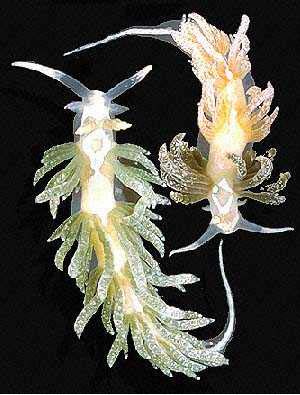
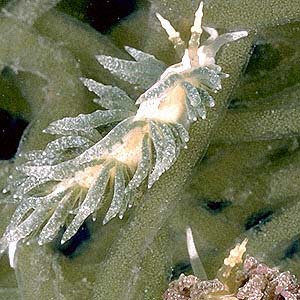
Favorinus japonicus
Baba, 1949
Order: NUDIBRANCHIA
Suborder: AEOLIDINA
Family: Glaucidae
DISTRIBUTION
Found throughout the tropical western Pacific and Indian Oceans.
PHOTO
UPPER: Two animals showing how the colour of the animal changes as the colour of its food changes. The animal on the left has been feeding on green aplysiid eggs for some time and the cerata, containing green pigment from the food, are uniformly green. The animal on the right was previously feeding on pink eggs and has only recently moved to the green egg mass. Only the front cluster of cerata have, up to the time of the photograph, turned green. (Solitary Islands, Coffs Harbour Region, New South Wales. March 1988).
LOWER: Green animal on egg mass of Aplysia. The tiny dots in the egg mass are the individual eggs. In the bottom right corner you can see part of a pink animal, which has only recently moved onto this egg mass. (Solitary Islands, Coffs Harbour Region, New South Wales. March 1988).
PHOTOS: Bill Rudman.
RELATED TOPIC
Defensive colouration in sea slugs
Reference:
• Baba, K. (1949). Opisthobranchia of Sagami Bay collected by His Majesty The Emperor of Japan. Tokyo, p. 1-194, pls. 1-50
Rudman, W.B., 1998 (April 25) Favorinus japonicus Baba, 1949. [In] Sea Slug Forum. Australian Museum, Sydney. Available from http://www.seaslugforum.net/find/favojap
Related messages
Favorinus japonicus from Reunion Island
March 31, 2009
From: Hugues Flodrops
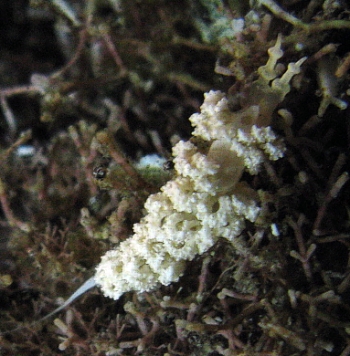
Concerning message #20796:
Dear Bill,
Here is a record of Favorinus japonicus from the Indian Ocean. Many specimens of this species were found on an a Hexabranchus egg-ribbon. Here it was on an algae covered rock at night.
Locality: Etang-Salé "Rocky coast", 1 metre, Reunion Island, Indian Ocean, 21 february 2009, Night. Length: 17 mm. Photographer: Hugues Flodrops.
A new picture for knowing it's distribution.
Regards.
Hugues
hugues.flodrops@wanadoo.fr
Flodrops,H., 2009 (Mar 31) Favorinus japonicus from Reunion Island. [Message in] Sea Slug Forum. Australian Museum, Sydney. Available from http://www.seaslugforum.net/find/22292Thanks Hugues,
This species has a wide distribution throughout the west Pacific and the Indian Ocean but another photo is always a welcome addition
Best wishes,
Bill Rudman
Favorinus japonicus on Hexabranchus eggs
September 25, 2007
From: Colin Ogden
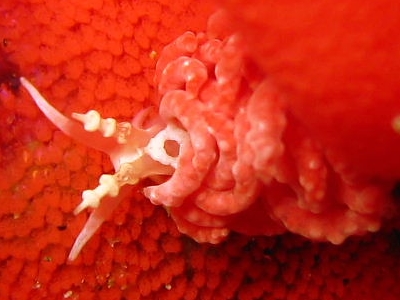
Dear Bill,
Malcolm Gedrim, one of our local divers, has passed this photo on to me, and it shows something I have never seen before together with a Favorinus tsuruganus feeding on what I think is a Hexabranchus sanguineus egg ribbon.
Locality: Sodwana Bay, 19 metres, South Africa, Indian, 22 September 2007, Coral Reef. Length: 10 mm. Photographer: Malcolm Gedrim.
Please can you help with the ID.
Thanks a ton for all the help you have givenso far. It really is appreciated
regards
Colin
scubaco@iafrica.com
Ogden C M, 2007 (Sep 25) Favorinus japonicus on Hexabranchus eggs. [Message in] Sea Slug Forum. Australian Museum, Sydney. Available from http://www.seaslugforum.net/find/20796Dear Colin,
It's almost certain that if you find an aeolid on an opisthobranch egg mass it will be a species of Favorinus, which all specialise on eating eggs. This is Favorinus japonicus. Interestingly we have a message from Dong Bum Koh showing the same two species together, from the other end of the Indo-West Pacific [#13700 ]
Best wishes,
Bill Rudman
More photos of Favorinus japonicus
May 10, 2005
From: Dong Bum Koh
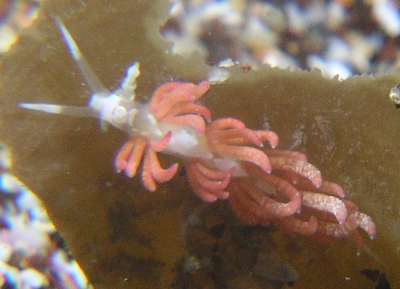
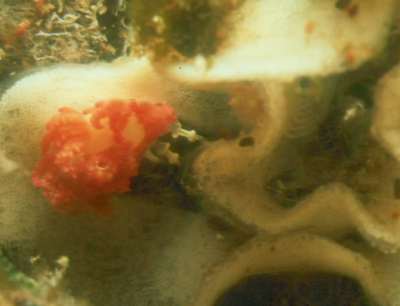
Dear Bill,
Here are some other photos of Favorinus japonicus that I found on the egg band of Dendrodoris denisoni. I actually observed these eggs being laid by D. denisoni & in my prior message (#13700) the eggs are also from D. denisoni.
There is also a small whitish coil-like egg band in this image that looks like the eggs of F. japonicus. I moved the slug just a short distance to take the upper whole body image.
Locality: Hwa Soon, South Korea. Pacific. Depth: 4 m. Length: several mm. 28 Nov. 2004. Sandy bottom with Rock Wall. Photographer: Dong Bum Koh
Best regards,
Dong Bum Koh
drkoh@seasee.co.kr
D. B. Koh, 2005 (May 10) More photos of Favorinus japonicus. [Message in] Sea Slug Forum. Australian Museum, Sydney. Available from http://www.seaslugforum.net/find/13709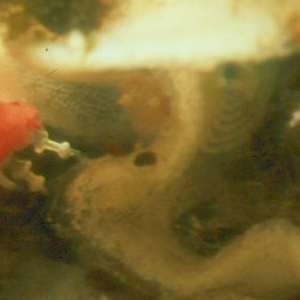
Dear Koh,
Thanks very much for these photos and for the ones showing Dendrodoris denisoni laying its egg ribbon which I have posted separately [message #13680]. In the close-up alongside we can see on the left, the typical rhinophores of F. japonicus, and on the right, the narrow spiralling egg ribbon on a Favorinus.
Best wishes,
Bill Rudman
Favorinus japonicus and F. tsuruganus together
May 3, 2005
From: Dong Bum Koh
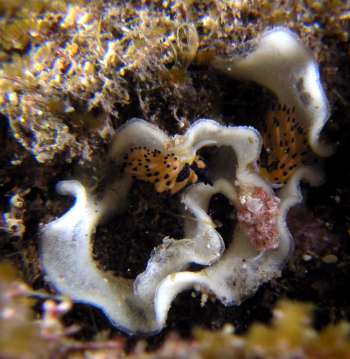
Dear Bill,
Here is a photo where we can see two Favorinus tsuruganus and two Favorinus japonicus. One F. japonicus is behind the egg band and we can only see a small part of its rhinophores.
Locality: Hwa Soon, South Korea. Depth: 4 m. Length: Several mm. 17 Nov. 2004. Sandy bottom with Rock Wall. Photographer: Youn Byung Ro
Best regards,
Dong Bum Koh
drkoh@seasee.co.kr
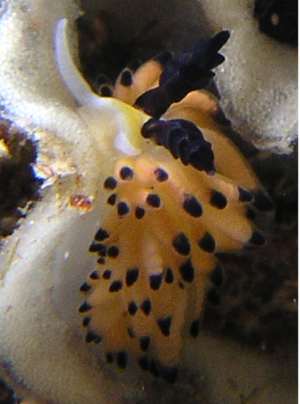
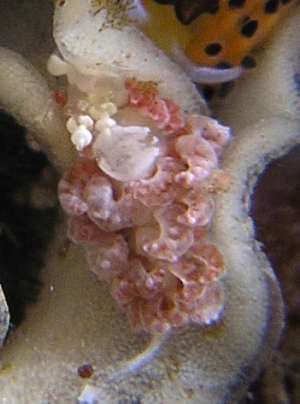
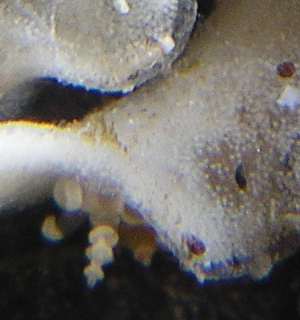
Dear Koh,
I'm glad you mentioned the second animal of F. japonicus or I think I would have missed it. I have included a close-up to show it, alongside. The photo shows the quite differently shaped rhinophores of each species very well.
Best wishes,
Bill Rudman
Re: Favorinus eating Hexabranchus eggs
December 1, 2003
From: Yves Coze
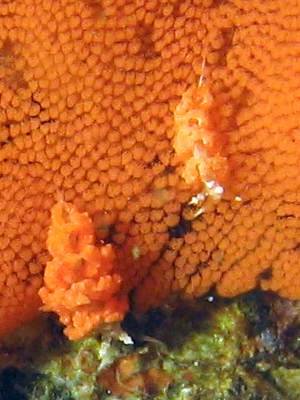
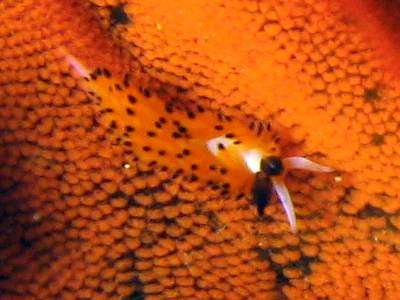
Dear Bill,
In addition to the pictures I've sent previously, here are some photos of the Favorinus that are not blurred. They are from Reunion Island, Indian Ocean
Once again they were spotted in a Hexabranchus sanguineus egg ribbon.
Best Regards
Yves Coze
info@rando-reunion.com
Coze, Y., 2003 (Dec 1) Re: Favorinus eating Hexabranchus eggs. [Message in] Sea Slug Forum. Australian Museum, Sydney. Available from http://www.seaslugforum.net/find/11545Dear Yves,
Thanks for the photos. They are of two species. The ones in the upper photo are the same as the 'blurred' ones in your earlier message which I suspected were Favorinus japonicus. They are indeed that species.
The one in the lower photo is Favorinus tsuruganus. For cross reference I have posted your photos of F. tsuruganus in a separate message.
Best wishes
Bill Rudman
Favorinus? from Zushi, Japan
November 16, 2003
From: Akira Kurabayashi
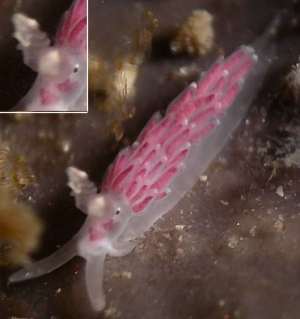
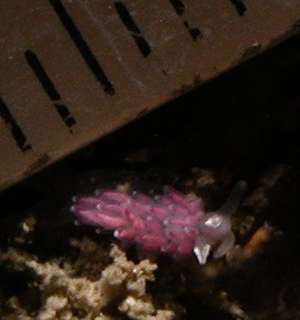
Hello, Dr. Rudman.
I found the animal that seems to be seaslug in Zushi,Japan. However, I do not know the name of this animal. Could you identify this animal?
photo: by Akira Kurabayashi
Date: 2 November 2003
Depth: 15m
Size: 3mm
Location: Zushi, The base of Miura Peninsula and the southern coast of the Sagami Bay, Japan
Best regards,
Akira Kurabayashi
kurabar@mba.nifty.com
Kurabayashi, A., 2003 (Nov 16) Favorinus? from Zushi, Japan. [Message in] Sea Slug Forum. Australian Museum, Sydney. Available from http://www.seaslugforum.net/find/11373Dear Akira,
It is quite difficult to identify nudibranchs when they are so small. Often juvenile shape and colour differ from that of adults. Despite that my guess would be that this is a species of Favorinus, and could possibly be Favorinus japonicus. But I could be quite wrong
Best wishes
Bill Rudman
Favorinus eating Hexabranchus eggs
September 5, 2003
From: Yves Coze
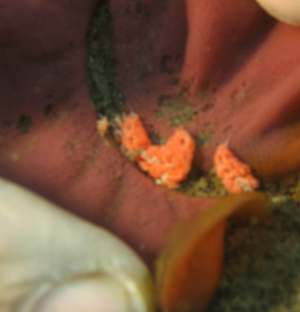
Dear Bill,
While diving in Reunion Island, Indian Ocean, we spotted these Hexabranchus sanguineus eggs on a rock. These were quite common in the place where we were.
While watching closely to the egg ribon, we noticed pinkish kind of larvae on the base of the ribbon. Unfortunately the picture we have are quite poor. These "things" were moving a little bit. Could they be spanish Dancer's larvae? In addition, it seems that the ribbon was not "full" some eggs seemed to be gone and the the ribbon was rather dark.
Yves Coze
info@rando-reunion.Com
Coze, Y., 2003 (Sep 5) Favorinus eating Hexabranchus eggs. [Message in] Sea Slug Forum. Australian Museum, Sydney. Available from http://www.seaslugforum.net/find/10871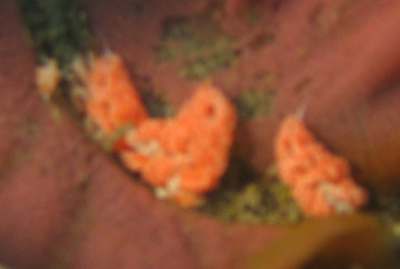
Dear Yves,
The larvae of Hexabranchus hatch out of the egg masses and swim away in the plankton. These little animals are another aspect of nature at work. They are nudibranchs which specialise on feeding on the eggs of other opisthobranchs. Although a bit fuzzy, I am sure they are aeolids of the genus Favorinus, and probably Favorinus japonicus. Have a look at my comments on Rokus Groeneveld's earlier report from the Red Sea.
Best wishes,
Bill Rudman
Favorinus on Hexabranchus eggs
July 12, 2003
From: Rokus Groeneveld
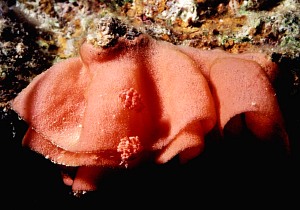
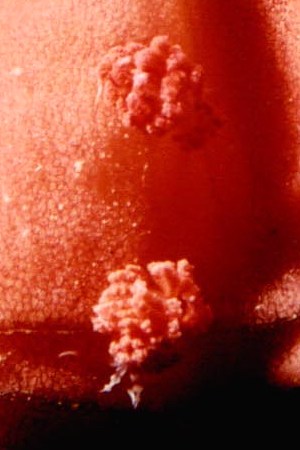
On the 13th of April 2002 I was on a nightdive on the housereef (Torfa)in Wahdi Lahmi (400 km south of Hurghada, Egypt). I found two small (about 10mm) what I think are nudibranches on the eggs of a Hexabranchus sanguineus.
From what I understand of all the pictures of juvenile Spanish Dancers on this site they're not that.
But then what are they? I'd be very pleased if someone could help me out?
Rokus Groeneveld
rosa12@wxs.nl
Groeneveld, R., 2003 (Jul 12) Favorinus on Hexabranchus eggs. [Message in] Sea Slug Forum. Australian Museum, Sydney. Available from http://www.seaslugforum.net/find/9863Dear Rokus,
You are quite right - they are not juvenile Hexabranchus. They are in fact an aeolid nudibranch of the genus Favorinus which specialise on feeding on the eggs of other sea slugs. Although some species of Favorinus apparently specialise on the egg ribbons of particular species, others like Favorinus japonicus, eat a wide variety of egg masses. Because a duct of their gut extends up into each of the cerata on their backs, they chnage colour depending on the colour of the eggs they are eating. As in your photo they are therefore well camouflaged when feeding on and egg ribbon. From the two swellings on their head tentacles or rhinophores I am pretty sure your animals are Favorinus japonicus. Two other species, Favorinus mirabilis and Favorinus cf. mirabilis, feed on Hexabranchus eggs but their rhinophores are quite different in shape.
Best wishes,
Bill Rudman
Re: Favorinus japonicus secondary metabolites
March 8, 2002
From: Jennifer Sneed
In answer to your question, I was considering studying F. japonicus for my master's degree. If I did, I would be looking to see if it sequestered chemicals from the eggs it eats. I am just not sure if it has already been looked at.
Jennifer
jenny_sneed@hotmail.com
Sneed, J., 2002 (Mar 8) Re: Favorinus japonicus secondary metabolites. [Message in] Sea Slug Forum. Australian Museum, Sydney. Available from http://www.seaslugforum.net/find/6389Dear Jenny,
It would be an interesting project. I suggest you get in touch with Kirsten Benkendorff [see her message about aplysiid eggs]. She may know of some recent work or work in progress,
Please keep us informed of your progress,
Best wishes,
Bill Rudman
Favorinus japonicus secondary metabolites
March 6, 2002
From: Jennifer Sneed
Hi,
I was just wondering if anyone out there knows if secondary metabolites have been looked at in Favorinus japonicus. If so could you refer me to information on the topic.
Thanks,
Jennifer Sneed
jenny_sneed@hotmail.com
Sneed, J., 2002 (Mar 6) Favorinus japonicus secondary metabolites. [Message in] Sea Slug Forum. Australian Museum, Sydney. Available from http://www.seaslugforum.net/find/6353Dear Jennifer,
I don't know of any reference to such a study, but I am sure if there is someone will let us know. Are you studying F. japonicus? Since they often feed on aplysiid eggs, I guess it is possible that they could end up with plant metabolites from the Sea Hare's food.
An intersting possibility,
Best wishes,
Bill Rudman
Favorinus japonicus from Heron Island
March 5, 2000
From: Julie Marshall
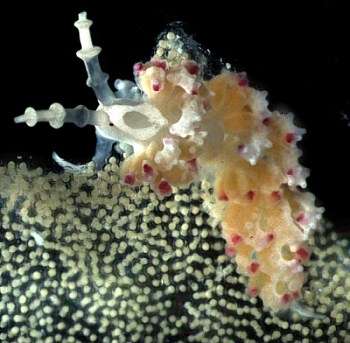
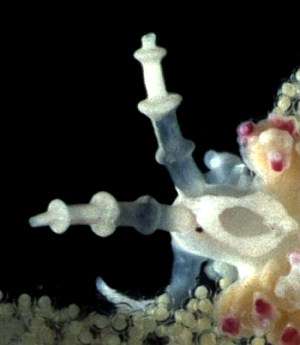
Dear Bill,
Attached is another colour variation of Favorinus japonicus. It was 10 mm in size and was found under a dead coral slab at the northern reef crest at Heron Island on 2 December 1999. It was feeding on the opisthobranch spawn shown in the photo. This animal shows some variation from most other Favorinus japonicus in having very pronounced (rather than small) annuli on the rhinophores and extremely nodulose cerata with cherry red tips. However it does have the usual opaque white daiamond on the head.
Best wishes,
Julie Marshall
j.marshall@latrobe.edu.au
Marshall, J., 2000 (Mar 5) Favorinus japonicus from Heron Island. [Message in] Sea Slug Forum. Australian Museum, Sydney. Available from http://www.seaslugforum.net/find/2025Thanks Julie,
Your animal certainly has very pronounced rings/brackets on the rhinophores.
Congratulations on your book.
Best wishes,
Bill Rudman.
Favorinus japonicus from Sulawesi
February 27, 2000
From: Lindsay Warren
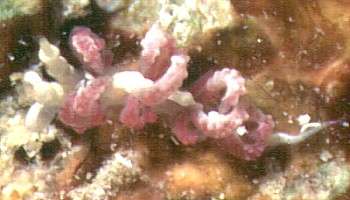
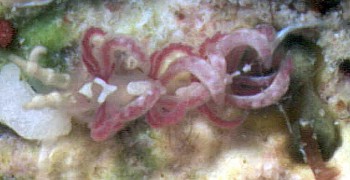
Dear Bill
This unidentified aeolid was found by Richard Smith at 3.30pm on 4 June 1999 at a depth of 8.5 m on dead coral on a wall of Pulau Hoga [Tukang Besi Archipelago, SE Sulawesi, Indonesia - Operation Wallacea]. Size: 5 mm.
The body is translucent off-white with distinct solid white patches on the notum behind the rhinophores. The first patch is triangular in shape, the second Y shaped followed by two to three other irregular patches towards the finely tapering tail. The cerata on either side of the body are
curled inwards, are pink with white nobs along their length. The rhinophores are annulate with eyespots just visible behind them. There are two sets of anterior tentacles - an upper longer pair tipped with white and a lower shorter pair not visible in the attached shots. Photos: Lindsay Warren.
Do you know what this might be?
All the best
Lindsay Warren
100014.2112@compuserve.com
Warren, L., 2000 (Feb 27) Favorinus japonicus from Sulawesi. [Message in] Sea Slug Forum. Australian Museum, Sydney. Available from http://www.seaslugforum.net/find/1965Dear Lindsay,
Nice to have an easy one now and again. This is Favorinus japonicus which is found throughout the Indo-West Pacific. As you will see fro other comments on the page this is animal feeds on opisthobranch eggs and its cerata gradually change colour as the colour of the eggs it is eating change.
Best wishes,
Bill Rudman.
Egg Predation - Favorinus japonicus
April 25, 1998
From: Bill Rudman
Species of the aeolid nudibranch Favorinus usually feed on Sea Slug eggs and sometimes on marine snail eggs as well. Favorinus japonicus is often found feeding on and laying its eggs on the egg masses of species of Aplysia and other Sea Hares ...Bill Rudman.
Rudman, W.B., 1998 (Apr 25). Comment on Egg Predation - Favorinus japonicus by Bill Rudman. [Message in] Sea Slug Forum. Australian Museum, Sydney. Available from http://www.seaslugforum.net/find/57